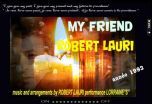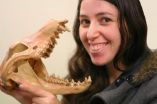(Press-News.org) Just one second, one heartbeat.
That's what is needed for a new, noninvasive functional imaging technology to record data for locating the source in the heart of a dangerous cardiac arrhythmia called ventricular tachycardia (VT).
VT is an abnormal, fast beating of the heart, which, if ignored, can lead to ventricular fibrillation, which causes some 400,000 cases of sudden death yearly in the United States alone.
The technique, developed by a Washington University in St. Louis scientist, is called Electrocardiographic Imaging (ECGI). It combines computerized tomography (CT) with 250 electrocardiograms recorded by electrodes placed on a vest across a patient's torso to map the source and pattern of VT in the heart and determine the kind of VT irregularity.
Using a special algorithm, ECGI can generate movies of the distinctive VT excitation waves, radiating like the wake caused by a pebble dropped into a pool, or rotating like a tornado, from recordings of multiple heartbeats.
While a wealth of information can be deduced from ECGI analysis of just one heartbeat, multiple heartbeats up to minutes long are often imaged to reveal even more about the nature of the arrhythmia.
Yoram Rudy, PhD, the Fred Saigh Distinguished Professor of Engineering, professor of biomedical engineering and of medicine and director of the Cardiac Bioelectricity and Arrhythmia Center (CBAC) at WUSTL, developed ECGI, first publishing on the technique in 2004.
Now, publishing in the Aug. 31, 2011, issue of Science Translational Medicine, Rudy and his collaborators in the Washington University departments of biomedical engineering and medicine, report the first systematic study of 25 cardiology patients with VT using ECGI to map noninvasively, beat by beat, the mechanisms and processes of VT in humans.
Co-authors WUSTL's Yong Wang, PhD, postdoctoral research associate in radiology who was a PhD student in Rudy's biomedical engineering lab, and Phillip S. Cuculich, MD, assistant professor of medicine at the School of Medicine, contributed equally to the study and are members of CBAC, an interdisciplinary center whose goals are to study heart rhythms and their disorders (cardiac arrhythmias) and to develop new tools for their diagnosis and treatment in the prevention of disabilities and cardiac death.
The other co-authors are Junjie Zhang; Kavit A. Desouza, MD; Ramya Vijayakumar; Jane Chen, MD; Mitchell N. Faddis, MD, PhD; Bruce Lindsay, MD; and Timothy W. Smith, DPhil, MD.
Saves hours of mapping
The heart, among other things, is an electric marvel. The 25 VT patients were scheduled to undergo catheter ablation to correct their electrical defects, but first underwent ECGI imaging.
The imaging correctly found the VT origin and categorized the two VT mechanisms, one called focal, comprising a mass of abnormal cells, the other re-entry, in which excitation waves become circular, forming a closed loop called a re-entry circuit.
In each mechanism, the heart's pacemaking activity is seized from its natural, normal site in the sinus node. Rudy and his collaborators showed that the abnormal excitation patterns of VT often began in scar tissues that were tell-tale signs of previous heart attacks.
The study is a breakthrough in the analysis and treatment of arrhythmias in general — VT specifically — because it is noninvasive, fast and can map electrical activity on the entire heart surface in one heartbeat.
Current noninvasive diagnosis of heart rhythms relies on the conventional ECG, which employs 12 electrodes on the body surface.
The ECG can only provide general information about the global heart electrical activity. To locate the source of VT in the heart, a patient must endure up to several hours of invasive mapping using an electrode-carrying catheter that is inserted into the heart and moved as a roving probe to obtain sequentially electrical recordings from many points.
Once the arrhythmia source has been located, ablation is performed to eliminate this source and stop the arrhythmia.
In the state-of-the-art protocol, ECGI would far more quickly find the source and type of VT, saving hours of mapping.
In the future, it is hoped that experimental techniques such as gamma knife radiosurgery and high-frequency ultrasound, under study for noninvasive ablation of cardiac tissue, might be used with ECGI, paving the way for total noninvasive treatment of VTs.
'Tool that opens the door'
ECGI can locate the source of cardiac excitation in the heart with an accuracy of about 6 millimeters. In contrast, the conventional ECG provides only global information.
As Rudy explains: "The big difference between the two is that the ECG measures the reflection of the heart's electrical activity far away from the heart on the torso surface. In the process, resolution is lost.
"ECGI gets far closer," Rudy says. "Imagine a car coming toward you at night from far away. You see only one light. But as it gets closer and closer, you start to resolve the two headlights and their location in space. It's similar here. With ECG, you're far on the body surface and get only a global view instead of the real local details on the heart surface.
"ECGI is a treasure for basic medical research. It is a tool that opens the door to study the electrical functioning of the heart and arrhythmia mechanisms in people with various (hereditary and non-hereditary) cardiac disorders.
"Clinically, it is promising as a diagnostic tool that could guide therapy of cardiac arrhythmias, and because it is noninvasive, it could also be used as a follow-up tool to evaluate progression of the disorder and the results of therapy," Rudy says.
"Someday it might help to identify patients at risk of developing VT, so that preventive measures can be taken before sudden death occurs.
"Nobody can imagine medicine today without noninvasive imaging. If you have a suspicious backache, you often get an MRI. Yet nothing like this has existed for cardiac arrhythmias, which, as our population ages, are becoming more and more common.
"There should be many ECGI revelations and applications in the future."
INFORMATION:
Dangerous arrhythmia analyzed in a heartbeat
Study shows noninvasive, fast way to map heart's electrical activity in one heartbeat
2011-09-01
ELSE PRESS RELEASES FROM THIS DATE:
First lizard genome sequenced
2011-09-01
The green anole lizard is an agile and active creature, and so are elements of its genome. This genomic agility and other new clues have emerged from the full sequencing of the lizard's genome and may offer insights into how the genomes of humans, mammals, and their reptilian counterparts have evolved since mammals and reptiles parted ways 320 million years ago. The researchers who completed this sequencing project reported their findings August 31 online in the journal Nature.
The green anole lizard (Anolis carolinensis) – a native of the Southeastern United States – ...
Research gives new hope to those with rare vascular cancer
2011-09-01
A specific genetic alteration has been discovered as a defining feature of epithelioid hemangioendothelioma (EHE), a rare but devastating vascular cancer. These findings have also been used to develop a new diagnostic test for this blood vessel disease.
An international research effort led by Brian Rubin, M.D., Ph.D., of Cleveland Clinic's Pathology and Laboratory Medicine Institute and Lerner Research Institute, devised an innovative approach to reveal the genetic alteration thought to cause EHE, which is considered uncommon: it comprises less than one percent of all ...
Adjuvant therapy perhaps not necessary for older breast cancer patients
2011-09-01
Breast cancer patients over the age of 60 with early-stage, hormone-responsive small tumors who forego adjuvant endocrine, also called hormonal therapy, are not at an increased risk of mortality compared to women of the same age without breast cancer, according to a study published Aug. 31 in the Journal of the National Cancer Institute.
The use of hormonal therapy has increased in breast cancer patients overall, and the 2009 St. Gallen International Breast Cancer Conference recommended hormonal therapy for almost all patients with hormone-responsive disease. But previous ...
UBC researchers find a new culprit in Alzheimer’s disease: Too many blood vessels
2011-09-01
University of British Columbia scientists may have uncovered a new explanation for how Alzheimer's disease destroys the brain – a profusion of blood vessels.
While the death of cells, whether they are in the walls of blood vessels or in brain tissue, has been a major focus of Alzheimer's disease research, a team led by Wilfred Jefferies, a professor in UBC's Michael Smith Laboratories, has shown that the neurodegenerative disease might in fact be caused by the propagation of cells in blood vessel walls.
Examining brain tissue from mouse models of Alzheimer's disease, ...
EUR10, 000 Guaranteed on Golden Riviera's Latest Slots Tourney
2011-09-01
Golden Riviera Online Casino recently announced that they will be hosting a Guaranteed EUR10,000 Slots Tournament on the superb Video Slot, Hitman. Golden Rivera was the first in the industry to host a Slots Tournament of this kind and magnitude and to say that the previous EUR10K tourneys were an astounding success with its patrons would be an understatement.
Casino Manager, Emily Alessi, released this statement to the press: "The time has come again for our famous EUR10,000 Guaranteed FreeRoll Slots Tourney. Every one of our previous EUR10K tourneys has had such ...
Leicester scientists deploy space-age technologies at science-fiction style 'sick bay'
2011-09-01
A new hi-tech £1million-plus non-invasive disease detection facility, developed by the University of Leicester, has been unveiled today (Sept 1st 2011) for use in Leicester Royal Infirmary's A&E department.
It is designed to detect the "sight, smell and feel" of disease without the use of invasive probes, blood tests, or other time-consuming and uncomfortable procedures.
Scientists use three different types of cutting-edge technology in combination under a range of situations. All the methods are non-invasive, and could speed up diagnosis.
Scientists have surrounded ...
Robert Lauri: Discovery of Unreleased Timeless Musical Creations
2011-09-01
Robert Lauri reveals a new window of his musical creativity by now offering listeners some previously unreleased timeless melodies... all of them simply stunning.
The artist introduces us to some of the songs performed in English by Lorraine S'. All of his melodies and arrangements offer an opportunity for today's artists and performers.
For example, Robert Lauri first introduces us to the selections My Friend, Promised Land and Sunset. Wix widgets will be shared on Robert Lauri's social networking sites as well as on his music sites.
During his long musical ...
Tasmanian tiger's jaw was too small to attack sheep, study shows
2011-09-01
Australia's iconic thylacine, or Tasmanian tiger, was hunted to death in the early Twentieth century for allegedly killing sheep; however, a new study published in the Zoological Society of London's Journal of Zoology has found that the tiger had such weak jaws that its prey was probably no larger than a possum.
"Our research has shown that its rather feeble jaw restricted it to catching smaller, more agile prey," said lead author Marie Attard, of the University of New South Wales Computational Biomechanics Research Group. "That's an unusual trait for a large predator ...
Hubble movies provide unprecedented view of supersonic jets from young stars
2011-09-01
Stars aren't shy about sending out birth announcements. They fire off energetic jets of glowing gas travelling at supersonic speeds in opposite directions through space.
Although astronomers have looked at still pictures of stellar jets for decades, now they can watch movies, thanks to the NASA/ESA Hubble Space Telescope.
An international team of scientists led by astronomer Patrick Hartigan of Rice University in Houston, USA, has collected enough high-resolution Hubble images over a 14-year period to stitch together time-lapse movies of young jets ejected from three ...
Smoking after menopause may increase sex hormone levels
2011-09-01
A recent study accepted for publication in The Endocrine Society's Journal of Clinical Endocrinology & Metabolism (JCEM) found that postmenopausal women who smoke have higher androgen and estrogen levels than non-smoking women, with sex hormone levels being highest in heavy smokers.
Previous studies have shown that high levels of estrogens and androgens are potential risk factors for breast and endometrial cancer as well as type 2 diabetes. Cigarette smoking is a well established risk factor for chronic diseases such as cancer, cardiovascular disease and diabetes, but ...
LAST 30 PRESS RELEASES:
Tracing the quick synthesis of an industrially important catalyst
New software sheds light on cancer’s hidden genetic networks
UT Health San Antonio awarded $3 million in CPRIT grants to bolster cancer research and prevention efforts in South Texas
Third symposium spotlights global challenge of new contaminants in China’s fight against pollution
From straw to soil harmony: International team reveals how biochar supercharges carbon-smart farming
Myeloma: How AI is redrawing the map of cancer care
Manhattan E. Charurat, Ph.D., MHS invested as the Homer and Martha Gudelsky Distinguished Professor in Medicine at the University of Maryland School of Medicine
Insilico Medicine’s Pharma.AI Q4 Winter Launch Recap: Revolutionizing drug discovery with cutting-edge AI innovations, accelerating the path to pharmaceutical superintelligence
Nanoplastics have diet-dependent impacts on digestive system health
Brain neuron death occurs throughout life and increases with age, a natural human protein drug may halt neuron death in Alzheimer’s disease
SPIE and CLP announce the recipients of the 2025 Advanced Photonics Young Innovator Award
Lessons from the Caldor Fire’s Christmas Valley ‘Miracle’
Ant societies rose by trading individual protection for collective power
Research reveals how ancient viral DNA shapes early embryonic development
A molecular gatekeeper that controls protein synthesis
New ‘cloaking device’ concept to shield sensitive tech from magnetic fields
Researchers show impact of mountain building and climate change on alpine biodiversity
Study models the transition from Neanderthals to modern humans in Europe
University of Phoenix College of Doctoral Studies releases white paper on AI-driven skilling to reduce burnout and restore worker autonomy
AIs fail at the game of visual “telephone”
The levers for a sustainable food system
Potential changes in US homelessness by ending federal support for housing first programs
Vulnerability of large language models to prompt injection when providing medical advice
Researchers develop new system for high-energy-density, long-life, multi-electron transfer bromine-based flow batteries
Ending federal support for housing first programs could increase U.S. homelessness by 5% in one year, new JAMA study finds
New research uncovers molecular ‘safety switch’ shielding cancers from immune attack
Bacteria resisting viral infection can still sink carbon to ocean floor
Younger biological age may increase depression risk in older women during COVID-19
Bharat Innovates 2026 National Basecamp Showcases India’s Most Promising Deep-Tech Ventures
Here’s what determines whether your income level rises or falls
[Press-News.org] Dangerous arrhythmia analyzed in a heartbeatStudy shows noninvasive, fast way to map heart's electrical activity in one heartbeat



